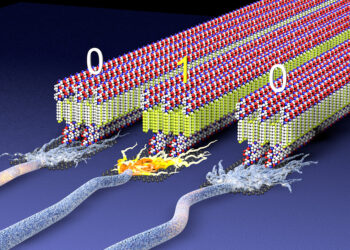“Some time ago, we showed that it is possible to induce an inverse phase transition in magnetite,” says physicist Fabrizio Carbone at EPFL. “It’s as if you took water and you could turn it into ice by putting energy into it with a laser. This is counterintuitive as normally to freeze water you cool it down, i.e. remove energy from it.”
“Some time ago, we showed that it is possible to induce an inverse phase transition in magnetite,” says physicist Fabrizio Carbone at EPFL. “It’s as if you took water and you could turn it into ice by putting energy into it with a laser. This is counterintuitive as normally to freeze water you cool it down, i.e. remove energy from it.”
Now, Carbone has led a research project to elucidate and control the microscopic structural properties of magnetite during such light-induced phase transitions. The study discovered that using specific light wavelengths for photoexcitation the system can drive magnetite into distinct non-equilibrium metastable states (“metastable” means that the state can change under certain conditions) called “hidden phases”, thus revealing a new protocol to manipulate material properties at ultrafast timescales. The findings, which could impact the future of electronics, are published in PNAS.
What are “non-equilibrium states”? An “equilibrium state” is basically a stable state where a material’s properties do not change over time because the forces within it are balanced. When this is disrupted, the material (the “system”, to be accurate in terms of physics) is said to enter a non-equilibrium state, exhibiting properties that can border on the exotic and unpredictable.
The “hidden phases” of magnetite
A phase transition is a change in a material’s state, due to changes in temperature, pressure, or other external conditions. An everyday example is water going from solid ice to liquid or from liquid to gas when it boils.
Phase transitions in materials usually follow predictable pathways under equilibrium conditions. But when materials are driven out of equilibrium, they can start showing so called “hidden phases” – intermediate states that are not normally accessible. Observing hidden phases requires advanced techniques that can capture rapid and minute changes in the material’s structure.
Magnetite (Fe3O4) is a well-studied material known for its intriguing metal-to-insulator transition at low temperatures – from being able to conduct electricity to actively blocking it. This is known as the Verwey transition, and it changes magnetite’s electronic and structural properties significantly.
With its complex interplay of crystal structure, charge, and orbital orders, magnetite can undergo this metal-insulator transition at around 125 K.
Ultrafast lasers induce hidden transitions in magnetite
“To understand this phenomenon better, we did this experiment where we directly looked at the atomic motions happening during such a transformation,” says Carbone. “We found out that laser excitation takes the solid into some different phases that don’t exist in equilibrium conditions.”
The experiments used two different wavelengths of light: near-infrared (800 nm) and visible (400 nm). When excited with 800 nm light pulses, the magnetite’s structure was disrupted, creating a mix of metallic and insulating regions. In contrast, 400 nm light pulses made the magnetite a more stable insulator.
To monitor the structural changes in magnetite induced by laser pulses, the researchers used ultrafast electron diffraction, a technique that can “see” the movements of atoms in materials on sub-picosecond timescales (a picosecond is a trillionth of a second).
The technique allowed the scientists to observe how the different wavelengths of laser light actually affect the structure of the magnetite on an atomic scale.
Magnetite’s crystal structure is what is referred to as a “monoclinic lattice”, where the unit cell is shaped like a skewed box, with three unequal edges, and two of its angles are 90 degrees while the third is different.
When the 800 nm light shone on the magnetite, it induced a rapid compression of the magnetite’s monoclinic lattice, transforming it towards a cubic structure. This takes place in three stages over 50 picoseconds, and suggests that there are complex dynamic interactions happening within the material. Conversely, the 400 nm, visible light caused the lattice to expand, reinforcing the monoclinic lattice, and creating a more ordered phase – a stable insulator.
Fundamental implications and technological applications
The study reveals that the electronic properties of magnetite can be controlled by selectively using different light wavelengths. Understanding these light-induced transitions provides valuable insights into the fundamental physics of strongly correlated systems.
“Our study breaks ground for a novel approach to control matter at ultrafast timescale using tailored photon pulses,” write the researchers. Being able to induce and control hidden phases in magnetite could have significant implications for the development of advanced materials and devices. For instance, materials that can switch between different electronic states quickly and efficiently could be used in next-generation computing and memory devices.
Other contributors
- Politecnico di Milano
- University of Milano-Bicocca
Reference
Truc, B., Usaia, P., Pennacchio, F., Berruto, G., Claude, R., Madan, I., Sala, V., LaGrange, T., Vanacore, G. M., Benhabib, S., & Carbone, F. (2024). Ultrafast generation of hidden phases via energy-tuned electronic photoexcitation in magnetite. PNAS 20 June 2024. DOI: 10.1073/pnas.2316438121
Journal
Proceedings of the National Academy of Sciences
Article Title
Ultrafast generation of hidden phases via energy-tuned electronic photoexcitation in magnetite.
Discover more from Science
Subscribe to get the latest posts sent to your email.



